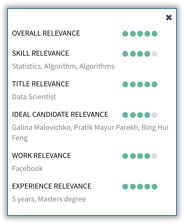 I recently caught up with Ashutosh Garg, CEO at Eightfold.ai to discuss how he and his team have deployed AI and machine learning to help with the needs of the talent management industry. With 6000+ research citations, 50+ patents, 35+ peer-reviewed research publications, and the outstanding Ph.D. thesis award from UIUC for his Ph.D. thesis in Machine Learning, it’s fair to say that Ashutosh is one of the world’s experts in machine learning. After his time managing Search and Personalization efforts at both Google and IBM Research, Ashutosh founded Bloomreach, a leading vendor for Digital Experience Platforms. Now, he is applying his experience to the problem he is most truly passionate about —helping the world’s talent find their most meaningful and fulfilling work.
I recently caught up with Ashutosh Garg, CEO at Eightfold.ai to discuss how he and his team have deployed AI and machine learning to help with the needs of the talent management industry. With 6000+ research citations, 50+ patents, 35+ peer-reviewed research publications, and the outstanding Ph.D. thesis award from UIUC for his Ph.D. thesis in Machine Learning, it’s fair to say that Ashutosh is one of the world’s experts in machine learning. After his time managing Search and Personalization efforts at both Google and IBM Research, Ashutosh founded Bloomreach, a leading vendor for Digital Experience Platforms. Now, he is applying his experience to the problem he is most truly passionate about —helping the world’s talent find their most meaningful and fulfilling work.
insideBIGDATA: Eightfold.ai states it is using AI and machine learning to address the needs of the talent management space. Can you give us a sense for what form of AI/machine learning is being used in your product?
Ashutosh Garg: Search, Recommendation and Personalization – at scale – are the key foundation blocks of our Talent Intelligence Platform for Eightfold.ai. Underneath the covers, we use Deep Learning to take the candidate data available inside the enterprise and combine it with publicly available data to create a current, rich and deep profile of candidates. This is a hard problem and requires multiple levels of abstraction. We use various machine learning primitives like Word Embeddings, Neural Networks, Boosted Decision Trees and Long Short-term Memory (LSTM) to name a few to solve this problem. Our ability to understand the context of all available data, allows us to (a) focus on candidates’ capabilities – not just the keywords listed in their resumes (b) present the relevancy of those capabilities to available job opportunities.
While most solutions in the market use keyword or boolean search, we are able to predict “what’s next” for a candidate – whether they are outside looking into a company or an employee looking to find the best next job internally. Our deep learning models are purpose built for people and jobs and allow us take all the disparate data points available to make an informed and transparent recommendation. The ability to explain “why” builds tremendous trust and confidence in both the candidate and the employer to rely on the TIP platform.
insideBIGDATA: Your TIP uses data sources like: publicly available data, internal data repositories, HRM systems, ATS tools and spreadsheets, etc. Can you describe a customer’s typical data pipeline and storage solution (cloud vs. on premise)? Also, please describe your API-based data integration strategy to connect with legacy back-end systems.
Ashutosh Garg: We believe that every data point allows to create a more complete picture about the candidate and help us determine the “fit” to available jobs. TIP is built to integrate with any digital source easily and quickly – spanning from systems with APIs to directories with resumes, pdf files, Word docs and everything in between.
Most customers who have been in business for a few years have a candidate pool 150 times their employee count sitting in disparate systems in their company. However, this repository of talent data is not used effectively – if at all – while sourcing candidates for open jobs. Most companies ignore people applying on their website to open jobs and continue to waste money on archaic systems and manual processes to source candidates.
The cost and time in finding new talent is further exacerbated by 15-25% attrition among existing employees. A 5,000 employee organization, even if they don’t grow at all, still need to hire 1,000 new employees to replace the people who are leaving the company for other opportunities.
We have a cloud-based solution that is GDPR compliant, and provides easy and fast integration to disparate legacy sources for relevant candidate data. As a result, for the first time, the CFO has a record system for all of the talent data of their company – past candidates, current employees and alumni.
insideBIGDATA: How is AI and machine learning being used to achieve greater diversity in talent management by eliminating biases?
Ashutosh Garg: It has been widely researched and proven that by implementing and hiring a diverse workforce, businesses have witnessed increased organizational performance, an influx of innovative perspectives and high diversification of the labor market. In one UK study, researchers found that greater gender diversity on the executive team could positively affect performance. Furthermore, for every 10% diversity increase that businesses executed, profits increased by a notable 3.5%. While large businesses and companies are aware of these statistics, they often lack the capacity to do anything about it; in other words, they are not supplied with an efficient technological method of ensuring diversity in their talent acquisition practices.
How does AI come into play with this? In talent acquisition, AI discloses which applicants are an advantageous fit for available positions within the company by correlating skills to mathematical algorithms. Our diversity product allows the removal of any potential human bias via blind screening. In fact, our current customers, including AdRoll and DigitalOcean, are using Eightfold.ai to curate a more diverse organization. On the other hand, it emphasizes candidates with the utmost relevant expertise and experience in order to provide the maximum productivity potential for the desired position. By utilizing organizational management and big data, businesses can drive innovation and consequently reduce bias in employment decisions by helping companies make highly beneficial conclusions when it comes to hiring, performance evaluations and promotions, while simultaneously easing the financial strain of this process.
The bottom line is that this is an exciting era; this technological capability is going to give a fair employment shot to millions of job applications who wouldn’t have been considered previously. If used properly, Big Data—coupled with modern computational techniques—can improve person-job fit, increase a business’s ability to identify talent, raise equality in access to jobs and careers, and assist in overcoming implicit and explicit prejudice in the workplace. By putting this process into effect, Eightfold.ai is fully compliant with EEOC and does not use age, sex, race, religion, disability or any other personal traits in assessing fit of candidates to enterprise positions.
insideBIGDATA: “Explainability” of AI systems is a hot topic right now. How can your customers understand the reasons behind your hiring recommendations?
Ashutosh Garg: Employment is the backbone of society; simultaneously, one of business’ most complex problems is matching the right person with the right role. People pitch recruiting as if it were a transaction but however, in order to build a holistic platform, companies need to develop a process that solves this problem and creates work that is most meaningful to the highest amount of people. At the end of the day, companies have a say in what they’re looking for. When it comes to diversity, for example, they can input whether they’re searching for men or women, or people of a particular ethnic background.
Our platform provides visibility into each of the recommendations, so both the candidate and the employer understand why they are a good fit for a specific role. As an example, the attached picture shows the various factors that matter to the employer:

Eightfold.ai can actually put exemplary candidates in the space that businesses want to ideally mirror; the system will look at what the applicant has achieved throughout their career and how relevant their experience level is in the current role. This ranking system of matching has been developed through parsing and analyzing countless pieces of data to create a model of any business, regardless of the industry. Once the job has been calibrated, that’s where the magic happens. During the recruitment process, the first step that most people ignore is inbound applicants. This caused me to analyze how I can arrive into my system, examine the list of 150 people or so and find the one significant person that I need for this role?
We use all of this data to see who has performed advantageously in an organization and then we build models over all of it in order to figure out who is capable of completing the necessary responsibilities for the position. There are two highly essential functions at work: developing a business’s talent network and mapping how people have expanded from one career advancement to the next. Through this process, our system has the ability to not only match candidates to the roles they applied to, but other ones that they are perfect fits for and the system will additionally explain why. This repairs the challenges of LinkedIn connections and can actually show users who their most useful referrals would be and why.
insideBIGDATA: What future directions are you planning to follow in terms of the AI/machine learning technology you’re using in your product?
Ashutosh Garg: We are constantly working on making our offering smarter by collecting data from more data streams, making our AI smarter and working on presenting the results in the best understandable format. For the candidates one of the major pain points today is guidance and direction around learnability of new skills. Technology is changing everyday and people are on the lookout to expand their skill set.
Eightfold’s AI technology already understands a candidate’s resume in detail and this will be expanded to bring a Personalized Career Coach to each and every individual. The same idea can be applied by recruiters to hire candidates who don’t possess a required skill but are capable of acquiring it. This will create a new search paradigm where recruiters start searching for candidates who can acquire the skills in the job requirement fast.
For recruiters and hiring managers we are working on deeper integration with the HR performance evaluation systems. This will help our AI systems understand what makes a candidate successful in the long term within the company. Today’s recruiting systems are optimized for bringing in candidates who will be interviewed by the company. Eightfold’s deeper integration with the HR systems will let company interview candidates who will be successful in the company. This will also help understand the skill composition of successful individuals and teams within the company. This will lead to Eightfold AI helping with building successful teams within a company.
Sign up for the free insideBIGDATA newsletter.





Any work that has ben done in the area of ERP and use test scripts and defect management? We want to see how we can help client with SAP, DEFECTS and reduce time and effort.